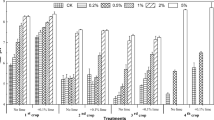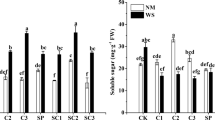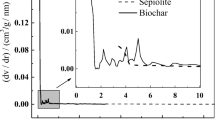Abstract
Purpose
Little is known of the effect of sepiolite on the transformation of Cd in anthropogenically contaminated paddy soil under different moisture conditions; therefore, we studied the effects of sepiolite and flooding on the extractability and fractionation of Cd in paddy soils.
Materials and methods
The dynamics of soil Eh, pH, DTPA-extractable Cd, and different Cd soil fractions were studied in two typical paddy soils from south China that were spiked with 10 mg kg–1 Cd following amendment with sepiolite at 5 and 10 g kg–1 soil during a 30-day incubation period at 25°C, with either no flooding or continuous flooding conditions.
Results and discussion
The addition of sepiolite at two rates of 5 and 10 g kg–1 soil resulted in an average reduction in soil Eh of 76 and 93 mV, increase in soil pH of 1.2 and 2.3 pH units, and decrease in DTPA-extractable Cd in soils of 1.43 and 2.53 mg kg–1 under continuous flooding conditions, respectively. Sepiolite addition resulted in a significant decrease in the exchangeable Cd in the soils, and a significant increase, in the carbonate-bound and Fe/Mn oxide-bound Cd in the soils under both moisture conditions. Cadmium was also immobilized by flooding and by interactions between sepiolite application and flooding; these effects were greater in sandy paddy soil than in clay paddy soil.
Conclusions
The immobilization of Cd in typical paddy soils was related mainly to changes in Eh and pH caused by the addition of sepiolite and flooding. Sepiolite can be used in the remediation of Cd-contaminated paddy soils, especially in sandy paddy soils, and flooding enhances the stabilization of Cd in paddy soils by sepiolite.




Similar content being viewed by others
References
Ahmad HR, Ghafoor A, Corwin DL, Aziz MA, Saifullah SM (2011) Organic and inorganic amendments affect soil concentration and accumulation of cadmium and lead in wheat in calcareous alkaline soils. Commun Soil Sci Plant Anal 42:111–122
Álvarez-Ayuso E, García-Sánchez A (2003) Sepiolite as a feasible soil additive for the immobilization of cadmium and zinc. Sci Total Environ 305:1–12
Badora A, Furrer G, Grünwald A, Schulin R (1998) Immobilization of zinc and cadmium in polluted soils by polynuclear Al13 and Al-montmorillonite. J Soil Contam 7(5):573–588
Bjerre GK, Schierup H (1985) Influence of flooding on availability and uptake of heavy metals by oat grown in different soils. Plant Soil 88:45–56
Chapman HD (1965) Cation exchange capacity. In: Black CA (ed) Methods of soil analysis. American Society of Agronomy. American Society for Testing and Materials, Madison, pp 891–901
Chen ZS, Lee GJ, Liu JC (2000) The effects of chemical remediation treatments on the extractability and speciation of cadmium and lead in contaminated soils. Chemosphere 41:235–242
Cheng SF, Hseu ZY (2002) In-situ immobilization of cadmium and lead by different amendments in two contaminated soils. Water Air Soil Pollut 140:73–84
Elliott HA, Liberati MR, Huang CP (1986) Competitive adsorption of heavy metals by soil. J Environ Qual 15:214–219
Gee GW, Bauder JW (1986) Particle-size analysis. In: Klute A et al (eds) Methods of soil analysis. Part 1. Physical and mineralogical method, 2nd edn. Madison, WI, USA
Hong CO, Lee DK, Kim PJ (2008) Feasibility of phosphate fertilizer to immobilize cadmium in a field. Chemosphere 70:2009–2015
Hooda PS, Alloway BJ (1998) Cadmium and lead sorption behaviour of selected English and Indian soils. Geoderma 84:121–134
Hu HQ (2006) Soil chemical properties. In: Huang QY (ed) Soil science. Chinese Agricultural Press, Beijing, p 175
Jalloh MA, Chen J, Zhen F, Zhang G (2009) Effect of different N fertilizer forms on antioxidant capacity and grain yield of rice growing under Cd stress. J Hazard Mater 162:1081–1085
Kashem MA, Singh BR (2001) Metal availability in contaminated soils: I. Effects of flooding and organic matter on changes in Eh, pH and solubility of Cd, Ni and Zn. Nutr Cycl Agroecosyst 61:247–255
Keller C, Marchetti M, Rossi L, Lugon-Moulin N (2005) Reduction of cadmium availability to tobacco (Nicotiana tabacum) plants using soil amendments in low cadmium-contaminated agricultural soils: a pot experiment. Plant Soil 276:69–84
Lindsay WL, Norvell WA (1978) Development of a DTPA soil test for zinc, iron, manganese, and copper. Soil Sci Soc Am J 42:421–428
National Bureau of Statistics of China (2010) China statistical yearbook. http://www.stats.gov.cn/tjsj/ndsj/2010/indexch.htm (access 26 October 2011, in Chinese)
Olsen SR, Somers LE (1982) Phosphorus. In: Page AL, Miller RH, Keene DR (eds) Methods of soil analysis, vol 2. Soil Science Society of America, Madison, pp 403–448
Özdemir O, Çınar M, Sabah E, Arslana F, Çelika MS (2007) Adsorption of anionic surfactants onto sepiolite. J Hazard Mater 147:625–632
Shirvani M, Kalbasi M, Shariatmadari H, Nourbakhsh F, Najafi B (2006a) Sorption–desorption of cadmium in aqueous palygorskite, sepiolite, and calcite suspensions: isotherm hysteresis. Chemosphere 65:2178–2184
Shirvani M, Shariatmadari H, Kalbasi M, Nourbakhsh F, Najafi B (2006b) Sorption of cadmium on palygorskite, sepiolite and calcite: equilibria and organic ligand affected kinetics. Colloids Surf A 287:182–190
State Environmental Protection Agency (2003) Investigation report of eco-environmental situation in China’s mid-east regions. Environ Prot 8:3–8, in Chinese
Sun L, Chen S, Chao L, Sun T (2007) Effects of flooding on changes in Eh, pH and speciation of cadmium and lead in contaminated soil. Bull Environ Contam Toxicol 79:514–518
Tessier A, Campbell PGC, Bisson M (1979) Sequential extraction procedure for the speciation of particulate trace metals. Anal Chem 51(7):844–851
Van Den Berg GA, Loch JPG, Winkels HJ (1998) Effect of fluctuating hydrological conditions on the mobility of heavy metals in soils of a freshwater estuary in the Netherlands. Water Air Soil Pollut 102:377–388
van Herwijnen R, Hutchings TR, Al-Tabbaa A, Moffat AJ, Johns ML, Ouki SK (2007) Remediation of metal contaminated soil with mineral-amended composts. Environ Pollut 150(3):347–354
Wang K, Xing B (2002) Adsorption and desorption of cadmium by goethite pretreated with phosphate. Chemosphere 48:665–670
Wei S, Niu R, Srivastava M, Zhou Q, Wu Z, Sun T, Hu Y, Li Y (2009) Bidens tripartite L.: a Cd-accumulator confirmed by pot culture and site sampling experiment. J Hazard Mater 170:1269–1272
Xu JQ, Hseung Y (1983) Layer silicate minerals of soil clay fraction. In: Hseung Y (ed) Soil colloid. I. Material basis of soil colloid. Science Press, Beijing, pp 92–94, in Chinese
Xu MG, Zhang Q, Zeng XB (2007) Effects and mechanism of amendments on remediation of Cd–Zn contaminated paddy soil. Environ Sci 28(6):1361–1366 (in Chinese)
Yang QW, Lan CY, Wang HB, Zhuang P, Shu WS (2006) Cadmium in soil–rice system and health risk associated with the use of untreated mining wastewater for irrigation in Lechang, China. Agr Water Manage 84:147–152
Zhang XL (2008) Physiological mechanisms of Cd hyperaccumulation by the ASME of Sedum alfredii H. and its regulation. Dissertation Zhejiang University (in Chinese)
Zhu QH, Huang DY, Zhu GX, Ge TD, Liu GS, Zhu HH, Liu SL, Zhang XN (2010) Sepiolite is recommended for the remediation of Cd-contaminated paddy soil. Acta Agric Scand Sect B Soil Plant Sci 60:110–116
Acknowledgments
This study was supported by the National Natural Science Foundation of China (41101300), the National Key Technologies R&D Program of China (2011BAD04B01), the Important National Science & Technology Specific Projects (2009ZX07212-0105), and the Knowledge Innovation Program of the Chinese Academy of Sciences (KZCX3-SW-437).
Author information
Authors and Affiliations
Corresponding authors
Additional information
Responsible editor: Jaco Vangronsveld
Rights and permissions
About this article
Cite this article
Zhu, QH., Huang, DY., Liu, SL. et al. Flooding-enhanced immobilization effect of sepiolite on cadmium in paddy soil. J Soils Sediments 12, 169–177 (2012). https://doi.org/10.1007/s11368-011-0444-2
Received:
Accepted:
Published:
Issue Date:
DOI: https://doi.org/10.1007/s11368-011-0444-2




